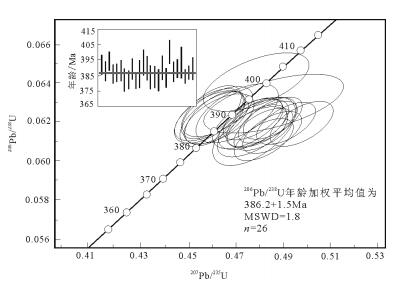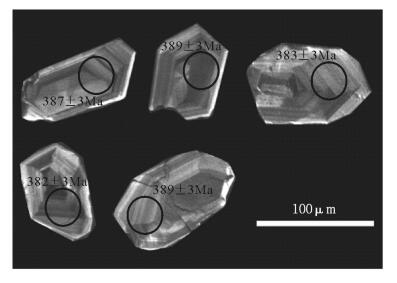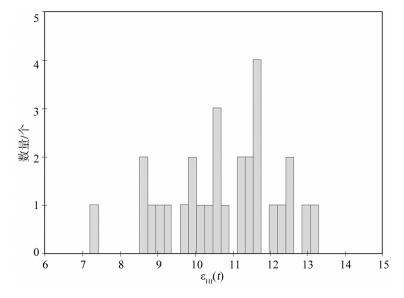Zircon U-Pb age and Hf isotope compositions of the wall rocks in the Sarshuoke gold-copper polymetallic deposit in Altay, Xinjiang: Implications for the ore-forming conditions
-
摘要:
新疆萨尔朔克金铜多金属矿床产于中泥盆统阿舍勒组上亚组的中酸性火山岩-次火山岩中, 地表以金(铜)矿化为主, 矿体形态及空间分布严格受NNW向断裂破碎带控制, 矿体呈脉状、透镜状。金(铜)矿石以蚀变岩型为主, 其次为石英脉型, 赋矿围岩为黄铁绢英岩化流纹斑岩。金主要赋存在微细粒黄铁矿等硫化物和脉石英中, 黄铜矿常呈不规则细脉状出现。在地表 100m以下, 出现铅锌矿化, 且向深部铅锌品位较高, 一般3%~5%, 最高达12%以上。流纹斑岩与金铜多金属矿关系密切。通过锆石U-Pb同位素测年和Hf同位素测试分析, 获得流纹斑岩的成岩年龄为386.2±1.5Ma, εHf(t)在7~13之间, 主要集中在8.5~12.5之间。上述结果表明, 流纹斑岩可能形成于早泥盆世晚期活动大陆边缘环境, 是俯冲增生的产物。铅锌矿化是386Ma流纹斑岩期后岩浆作用的产物, 而金铜矿化则是在含矿流纹斑岩的基础上, 经其后火山热液叠加作用发生的。
Abstract:The Sarshuoke gold-copper polymetallic deposit is hosted in the intermediate andestic-acidic volcanic-subvolcanic rocks of the Devonian Ashele Formation. Gold-copper(Au-Cu) mineralization mainly occurs at the shallow level(less than 100m in depth), and the shapes of veins and lenticular Au-Cu orebodies are significantly constrained by the NNW-trending faults. Au-Cu minerals exist mainly in hydrothermal altered rocks with some in the quartz veins, and the wall rocks are the pyritization-phyllicization rhyolite porphyry. Gold mainly occurs in fine-grained pyrite and other sulfides and quartz. The lead-zinc(Pb-Zn) ores are mainly distributed at lower level at ca.100m under the surface. The grade of Pb-Zn increases with the increasing depth. The grade of Pb-Zn ranges from 3% to 5%, and the highest grade could reach up to 12%. Au-Cu polymetallic mineralization is related closely to rhyolite porphyry. Zircon U-Pb dating shows that the wall rock of the deposit, i.e., rhyolite porphyry, crystallized at 386.2±1.5Ma. Zircon Lu-Hf isotope analysis yielded pronounced depleted Hf isotope composition with εHf(t) ranging from 7 to 13, mostly 9-10. The data obtained by the authors, in combination with regional geology and previous studies, reveal that the rhyolite porphyry was formed on an active continental margin related to plate subduction in late Early Devonian. Pb-Zn mineralization is genetically related to the rhyolite porphyry igneous activity. Furthermore, Au-Cu mineralization most possibly took place at the late stage and was ge-netically related to volcanic hydrothermal effects on the basis of Au-Cu-bearing rhyolite porphyry.
-
Keywords:
- gold-copper polymetallic deposit /
- U-Pb age /
- Lu-Hf isotope /
- ore-forming conditions /
- Sarshuoke /
- Xinjiang
-
云南腾冲境内的火山群东西宽50km,南北长90km,区内共有68座具较明显山体的火山(图 1)。其中火山机构保存完整(有火山口、火山锥)的有25座,火山锥火山口不明显的有18座,其余25座火山机构遭到严重破坏,但仍见火山山体[1]。除固东北部几座外,其余全在本次区域重力调查区内。火山区的热泉、温泉、地热资源如何分布,火山有没有可能再次喷发而造成灾害,这些问题因扰着众多研究者,因此有必要对腾冲火山区与重力场的关系进行分析,并对火山的喷发机制进行探索。
笔者以腾冲地区1:20万区域重力调查资料为主,结合其他物探方法(航空磁测、地震等)、地质资料等综合分析了腾冲地区的火山机构、喷发机制。
1. 地质特征
腾冲火山区火山口主要沿马站—腾冲一线呈南北向线状展布(图 1),在芒棒—五合一带也出现了火山口。伴随火山口出现的是大面积的火山岩,从新近系芒棒组上部的玄武岩,到第四系更新统、全新统的玄武岩、安山玄武岩、安山岩、安山英安岩、英安岩。这些火山岩全具有磁性(表 1),密度为2.12×103~2.57×103g/cm3(表 2),由于这些火山岩普遍具有气孔,所以密度均较低。
表 1 腾冲火山区主要岩(矿)石标本岩性磁参数测定统计成果Table 1. Statistical results of magnetic parameters of main rocks (ores) in Tengchong volcanic field地层代号 岩性 磁化率(K)/10-6×4π-SI 剩磁/(10-3A.m-1) 磁性 含量范围 平均值 含量范围 平均值 Q41b 玄武岩 510.24~2498.31 1529.62 2731.54~13409.25 7798.28 强磁性 Q42b 安山岩 520.13~1745.71 967.04 1395.68~5796.15 3693.69 磁性 Q32b 安山玄武岩 347.33~2670.33 1148.7 609.19~6218.05 3441.18 磁性 玄武岩 1257.78~1526.77 1392.27 961.19~1184.04 1072.61 磁性 Q3lb 玄武岩 256.61~2394.81 1034.48 548.61~33955 1859.84 磁性 Q1b 英安岩 595.01~3362.25 1199.82 583.07~4643.63 1904.65 磁性 N2m2 玄武岩 386.00~3003.10 1421.64 1035.62~8413.83 2620.06 磁性 粒玄岩 1246.27~2553.19 2039.6 574.29~11463.56 5755.39 磁性 ∈? 混合岩化片麻岩 50.11~716.45 195.45 30.07~337.11 87.99 弱磁 Pz1gl2 片麻岩 68.51~2668.79 573.71 34.15~2644 286.48 弱磁 Pz1g 片麻岩(混合岩化) 12.02~119.55 50.64 22.76~70.21 43.76 微磁性 表 2 腾冲地区主要地层密度参数Table 2. Rock density parameters of main strata in Tengchong area地层 代号 标本数/块 平均密度值/(g·cm-3) 第四系 Qhal 75 1.69 Qha 30 2.12 Qhαβ 60 2.26 Qhpl 25 1.84 Qpβ 30 2.48 Qpal 5 1.94 Qpα 20 2.5 Qpξ 25 2.57 新近系 N2m 115 1.88 二叠系 P2dd 70 2.65 Pk 35 2.53 P1b 15 2.5 泥盆系 D1g 60 2.62 梅家山岩群 Pt3eλ 20 2.65 高黎贡山岩群 Pt1GL 165 2.61 马站-腾冲及龙川江新生界之间主要为燕山期花岗岩。龙川江的东侧主要为元古宇高黎贡山群深变质岩,但主要岩性为片麻状花岗岩。花岗岩密度为2.61×103g/cm3(表 2),磁性为弱磁性(表 1)。
2. 重力场特征及解释
剩余重力异常(图 2-a)清楚地显示,火山区中部为一条南北向的重力正异常,东西宽约10km,南北从蒲川-曲石长约60km,剩余异常幅值2×10-5m/s2以上,异常中心位于打苴乡-勐连乡的东侧,最高值达到8×10-5m/s2。西侧北段为马站-腾冲重力负异常,负异常幅值较大,异常东侧还有一正异常,负异常两侧等值线密集,梯度变化剧烈,异常中心位于棕包园,最小值达到-13×10-5m/s2。中段清水一带,负异常较平缓,甚至出现了正异常。新华乡处似被正异常割断,然后是负异常。总体上,从马站-腾冲-蚂蝗塘仍为较连续的负异常。东侧皆为负异常,北段与高黎贡山重力低合为一体,南段芒棒-团田形成自行封闭的负异常,异常中心位于五合-龙江,负异常幅值达-9×10-5m/s2。东侧负异常总体与高黎贡山负异常合为一体,同时在高黎贡山负异常的背景上形成几处圈闭的负异常。曲石-蒲川正异常最大值与两侧负异常最小值差值达21×10-5m/s2。
通过该区的水平总梯度模重力异常图(图 2-b),可以清晰地反映出该区的梯度变化情况,曲石-蒲川重力高东西两侧皆形成了剧烈的梯级带,西侧主要出现在北段,梯度变化普遍高于3×10-5m/(s2·km-1),最高值达到5×10-5m/(s2·km-1)。东侧从南到北都出现了梯度异常,只是北段变化稍弱,但变化值高于1.5×10-5 m/(s2· km-1),南段变化较大,普遍高于2×10-5m/(s2· km-1),最高值达到4.75×10-5m/(s2· km-1)。在马站-腾冲还有一梯级带,变化值普遍高于2×10-5m/(s2· km-1),最高值达到4.5×10-5m/(s2·km-1),但梯级带延伸不长。
重力低所对应的地层是新生界火山岩及松散沉积,据物性统计,新生界密度较低,因此,重力低主要由新生界引起。重力高对应的地层主要为燕山期花岗岩,花岗岩本身密度较低,虽然相对于两侧的新生界密度较高,但两侧的新生界厚度并不大,且相对于龙川江东侧的元古宇没有密度差,但异常性质相反,曲石-蒲川为重力高,高黎贡山为重力低,说明曲石-蒲川重力高的下伏还应存在密度更高的物质,推测可能存在基性-超基性岩。
3. 航磁异常特征及解释
腾冲火山区航磁ΔT(图 3-a)主要为正磁异常背景,负异常主要出现在东北,区内形成规模较大的磁异常,马站-清水磁异常形如掌状,呈北北东向展布,幅值达到200nT,清水一带,异常向东南扭转呈南北向,并向南延伸至新华。另一异常呈南北向长条带状展布,从上营北一直延伸到蒲川,幅值也达到了200nT。打苴乡—蒲川有一狭长低值带,似将两异常分开。化极后,异常向北移动,腾冲磁异常移至马站—腾冲,形如脚掌,北宽南窄。东边的磁异常仍为长条带状,只是向北移动了。上延10km后(图 3-b),两异常合为一体。
磁异常对应的地层主要为新生界火山岩,据物性统计,这些火山岩均具有磁性,无疑磁异常是由新生代喷出地表的火山岩引起的。但曲石-蒲川虽呈一条狭长的低值带,上延后两侧的异常合为一体,况且上营-团田磁异常与沿龙川江出露的芒棒组并不对应,而是偏向西,且芒棒并不全是玄武岩。唯一的解释是曲石-蒲川的花岗岩下伏存在磁性物质,推测可能是基性-超基性岩。
4. 人工地震结果
1999年云南省地震局在腾冲地区实施了“腾深99人工地震测深工程”,纵测线南起潞西县中山乡,经潞西、龙陵、腾冲县团田、腾冲县城、固东、明光等地,至自治乡,全长178km。测线处北向南穿过大团山、小团山、大黑山、小黑山、大空山、小空山等多座火山。第一条横测线西起盈江的新城,经梁河、囊宋,向东经上营,至怒江边上的道街,全长约85km。第二条横测线从西端的猴桥,经古永、三联、曲石,至大坝,全长约50km(图 4)。以此为基础,云南省地震局进行了三维速度结构反演,图 4为三维速度截面图。资料显示在深度4~10km,位于团田与腾冲之间、热海东侧有一低速体,推测为岩浆囊[1-2]。
![]() 图 4 地震剖面及速度结构图(据参考文献[2]修改)六角星为爆破点,三角星为接收点,叉为速度模型节点Figure 4. Seismic profile and velocity structure
图 4 地震剖面及速度结构图(据参考文献[2]修改)六角星为爆破点,三角星为接收点,叉为速度模型节点Figure 4. Seismic profile and velocity structure5. 综合推断解释
在清水-芒棒图横切一条重磁剖面进行反演,从反演结果(图 5)可知,重力低同时具有高磁化强度的异常由第四系火山岩引起,因为第四系火山岩磁化率较高,而且该区火山岩气孔较发育,所以密度较低。高密度同时具有高磁化强度,经反演,由下伏基性岩引起。因该剖面与地震新城—道街剖面基本重合,剖面显示热海东侧下伏4~10km有一低速低,与重力高及磁异常的位置基本一致,所以高密度、高磁化强度的物质同时还具有低速的特性,那么满足这3个物理性质的物质只有基性岩浆。仔细比对地震新城-道街剖面及中山-自治剖面,低速体的位置与重力高磁异常基本一致。中山—自治地震剖面腾冲以北没有低速异常是因为腾冲以北剖面没有在重力高里面,而腾冲—团田段刚好穿过重力高,打破了以前关于岩浆囊是在火山热海下面的认识。从新城-自治剖面看,结果也一样,低速体并不在热海下方,而是在东侧,与重力高的位置重合。由此推测,在曲石-蒲川的重力高下面存在基性岩浆。整个火山机构包括马曲石-蒲川下覆的基性岩浆和通过两侧龙川江断裂与腾冲-盈江断裂喷出地表的火山岩。幔源挥发分释放强度空间分布(图 6)与相对地热梯度平面分布(图 7)反映的位置也与重力高基本一致。
![]() 图 7 腾冲火山区相对地热梯度平面分布[4](地热梯度单位为℃)Figure 7. Relative geothermal gradient plane distribution in Tengchong volcanic field
图 7 腾冲火山区相对地热梯度平面分布[4](地热梯度单位为℃)Figure 7. Relative geothermal gradient plane distribution in Tengchong volcanic field6. 结论
低密度的花岗岩上产生了重力高, 预示着下伏可能存在高密度的物质, 高磁指示下伏的物质应该是基性的, 而低速的特征说明该物质是塑性或流体的。综合高密度、强磁性、低速的特征, 推断该物质为还未固结的基性岩浆。通过重力高的范围和位置, 以及幔源挥发分释放强度空间分布与相对地热梯度平面分布, 基本可以确定腾冲火山下伏岩浆房的位置在曲石-蒲川重力高的下面。通过人工地震确定岩浆房的深度为4~10km, 有再次喷发的可能, 所以要做好监测与防范。通过重力梯级带可确定腾冲火山区下伏岩浆主要通过龙川江断裂与腾冲-盈江断裂喷出地表, 因此可通过区域重力划定的断裂来寻找地热资源加以利用。
致谢: 成文过程中得到中国地质调查局南京地质调查中心张传林研究员的帮助,审稿专家细致认真的审阅使文章质量有了很大提高,在此一并致谢。 -
表 1 流纹斑岩LA-ICP-MS锆石U-Th-Pb年龄数据(ALT007)
Table 1 LA-ICP-MS zircon U-Th-Pb age data of rhyolite porphyry(ALT007)
点号 Pb/10-6 Th/10-6 U/10-6 Th/U 206Pb/238U
比值1σ 207Pb/235U
比值1σ 207Pb/206Pb
比值1σ 206Pb/238U
年龄/Ma1σ 207Pb/235U
年龄/Mσ1σ 1 30 293 421 0.70 0.0627 0.0005 0.489 0.0057 0.0565 0.0006 392 3 404 5 2 28 244 412 0.59 0.0620 0.0006 0.460 0.0047 0.0538 0.0005 388 4 384 4 3 26 217 379 0.57 0.0629 0.0005 0.480 0.0050 0.0553 0.0006 393 3 398 4 4 23 164 340 0.48 0.0618 0.0005 0.489 0.0066 0.0574 0.0008 386 3 404 5 5 20 152 297 0.51 0.0618 0.0004 0.488 0.0068 0.0572 0.0008 387 3 403 6 6 23 192 337 0.57 0.0622 0.0005 0.460 0.0058 0.0537 0.0007 389 3 384 5 7 20 153 304 0.50 0.0612 0.0006 0.484 0.0067 0.0573 0.0008 383 3 400 6 8 26 238 382 0.62 0.0611 0.0005 0.482 0.0052 0.0572 0.0006 382 3 400 4 9 27 235 392 0.60 0.0623 0.0005 0.464 0.0044 0.0540 0.0005 389 3 387 4 10 24 187 352 0.53 0.0611 0.0005 0.480 0.0055 0.0569 0.0006 383 3 398 5 11 28 245 404 0.61 0.0617 0.0007 0.483 0.0052 0.0567 0.0007 386 4 400 4 12 9 59 129 0.46 0.0630 0.0006 0.486 0.0121 0.0560 0.0014 394 4 402 10 13 23 186 344 0.54 0.0624 0.0006 0.459 0.0054 0.0534 0.0006 390 4 384 4 14 18 116 267 0.43 0.0615 0.0006 0.486 0.0065 0.0573 0.0008 385 4 402 5 15 20 143 299 0.48 0.0614 0.0005 0.484 0.0059 0.0572 0.0007 384 3 401 5 16 21 159 315 0.50 0.0611 0.0006 0.476 0.0065 0.0565 0.0008 382 4 395 5 17 19 142 287 0.50 0.0624 0.0006 0.479 0.0061 0.0556 0.0007 390 4 397 5 18 15 98 229 0.43 0.0610 0.0004 0.483 0.0081 0.0575 0.0009 382 3 400 7 19 15 104 216 0.48 0.0641 0.0006 0.479 0.0094 0.0542 0.0011 401 4 397 8 20 25 205 360 0.57 0.0620 0.0005 0.485 0.0054 0.0567 0.0006 388 3 402 5 21 19 153 282 0.54 0.0623 0.0005 0.487 0.0070 0.0567 0.0008 390 3 403 6 22 18 127 261 0.49 0.0630 0.0008 0.493 0.0070 0.0568 0.0007 394 5 407 6 23 19 138 290 0.48 0.0615 0.0004 0.480 0.0066 0.0566 0.0008 385 2 398 5 24 25 212 352 0.60 0.0619 0.0004 0.498 0.0054 0.0583 0.0006 387 3 410 4 25 9 48 129 0.38 0.0704 0.0007 0.551 0.0153 0.0567 0.0015 439 5 445 12 26 19 147 286 0.51 0.0623 0.0006 0.462 0.0070 0.0537 0.0008 390 4 385 6 表 2 萨尔朔克金铜多金属矿床含矿流纹斑岩锆石Hf同位素组成(ALT007)
Table 2 Zircon Lu-Hf isotope compositions of the rhyolite porphyry(ALT007)
测点 年龄/Ma 176Yb/177Hf 176Lu/177Hf 176Hf/177Hf 2σ 176Hf/177Hfi εHf(0) εHf(t) TDM/Ma TDMC/Ma fLu/Hf ALT007.1 386 0.0807 0.0029 0.282835 0.000020 0.282814 2.2 10.0 623 894 -0.91 ALT007.2 386 0.0703 0.0025 0.282849 0.000019 0.282830 2.7 10.6 597 843 -0.92 ALT007.3 386 0.0934 0.0033 0.282762 0.000020 0.282738 -0.4 7.3 740 1138 -0.90 ALT007.4 386 0.0634 0.0023 0.282896 0.000019 0.282879 4.4 12.3 524 686 -0.93 ALT007.5 386 0.0687 0.0026 0.282796 0.000021 0.282777 0.9 8.7 676 1013 -0.92 ALT007.6 386 0.0662 0.0024 0.282839 0.000023 0.282821 2.4 10.2 609 871 -0.93 ALT007.7 386 0.0673 0.0024 0.282900 0.000018 0.282883 4.5 12.4 518 674 -0.93 ALT007.8 386 0.0779 0.0029 0.282871 0.000021 0.282850 3.5 11.3 569 778 -0.91 ALT007.9 386 0.0564 0.0022 0.282880 0.000021 0.282864 3.8 11.7 545 735 -0.93 ALT007.10 386 0.0751 0.0027 0.282825 0.000021 0.282805 1.9 9.7 635 922 -0.92 ALT007.11 386 0.0653 0.0023 0.282866 0.000021 0.282849 3.3 11.2 568 782 -0.93 ALT007.12 386 0.0706 0.0025 0.282847 0.000020 0.282829 2.6 10.5 598 847 -0.93 ALT007.13 386 0.0688 0.0025 0.282845 0.000021 0.282827 2.6 10.4 601 853 -0.93 ALT007.14 386 0.0651 0.0022 0.282799 0.000020 0.282783 1.0 8.9 664 994 -0.93 ALT007.15 386 0.0655 0.0024 0.282845 0.000021 0.282828 2.6 10.5 599 850 -0.93 ALT007.16 386 0.0613 0.0023 0.282852 0.000018 0.282835 2.8 10.7 588 827 -0.93 ALT007.17 386 0.0693 0.0026 0.282879 0.000025 0.282860 3.8 11.6 554 748 -0.92 ALT007.18 386 0.0816 0.0029 0.282833 0.000022 0.282812 2.2 9.9 626 901 -0.91 ALT007.19 386 0.0784 0.0027 0.282917 0.000022 0.282897 5.1 12.9 498 628 -0.92 ALT007.20 386 0.0815 0.0028 0.282881 0.000019 0.282860 3.8 11.6 553 746 -0.92 ALT007.21 386 0.0159 0.0006 0.282907 0.000025 0.282903 4.8 13.1 484 611 -0.98 ALT007.22 386 0.0705 0.0026 0.282876 0.000024 0.282857 3.7 11.5 557 757 -0.92 ALT007.23 386 0.0698 0.0025 0.282805 0.000020 0.282787 1.2 9.0 660 981 -0.93 ALT007.24 386 0.0825 0.0026 0.282814 0.000019 0.282795 1.5 9.3 649 955 -0.92 ALT007.25 386 0.0628 0.0023 0.282876 0.000021 0.282860 3.7 11.6 551 747 -0.93 ALT007.26 386 0.0720 0.0027 0.282907 0.000018 0.282887 4.8 12.6 513 660 -0.92 ALT007.27 386 0.0640 0.0023 0.282792 0.000017 0.282776 0.7 8.6 675 1017 -0.93 ALT007.28 386 0.0529 0.0020 0.282872 0.000021 0.282857 3.5 11.5 555 757 -0.94 ALT007.29 386 0.0745 0.0028 0.282897 0.000019 0.282877 4.4 12.2 529 695 -0.92 注:εHf(0)=[(176Hf/177Hf)S/(176Hf/177Hf)CHUR01]-10000,εHf(t)={[(176Hf/177Hf)S-(176Lu/177Hf)S-(eλt-1)]/[(176Hf/ 177Hf)CHUR0-(176Lu/177Hf)CHUR-(eλt-1)]-1}-10000,TDM1(Hf)=1/λ-ln{1 + [(176Hf/177Hf)S-(176Hf/177Hf)DM]/ [(176Lu/177Hf)S-(176Lu/177Hf)DM]},fLu/Hf=(176Lu/177Hf)S/(176Hf/177Hf)CHUR-1 -
陈毓川, 叶庆同, 冯京, 等.阿舍勒铜锌矿带成矿条件和成矿预测[M].北京:地质出版社, 1996:1-85. 叶庆同, 傅旭杰, 王保良.新疆阿尔泰山南缘多金属成矿带的成矿规律[J].地质学报, 1998, 72(4):349-357. 李景朝, 王世称, 杨毅恒.阿尔泰成矿区大型、超大型矿床成矿规律综合信息研究[J].吉林大学学报(地球科学版), 2002, 32(4):353-358. 王新安, 李月臣, 潘成泽, 等.阿尔泰晚古生代内生金属矿床成矿系列和成矿规律[J].矿床地质, 2006, 25(增刊):318-320. 董永观, 邢怀学, 高卫华, 等.阿尔泰成矿带构造演化与成矿作用[J].矿床地质, 2010, 29(增刊):1-2. 王登红, 陈毓川, 徐志刚, 等.阿尔泰成矿省的成矿系列及成矿规律[M].北京:原子能出版社, 2002:1-493. 王登红.新疆阿舍勒铜矿区双峰式火山岩与成矿背景的初步研究[J].地质论评, 1996, 42(1):45-53. 王京彬, 秦克章, 吴志亮, 等.阿尔泰山南缘火山喷流沉积型铅锌矿床[M].北京:地质出版社, 1998:1-210. 王少兵, 张少丽.新疆哈巴河萨尔朔克金矿地质特征及成因初探[J].新疆地质, 2001, 19(2):130-132. 李怀坤, 朱士兴, 相振群, 等.北京延庆高于庄组凝灰岩的锆石U-Pb定年研究及其对华北北部中元古界划分新方案的进一步约束[J].岩石学报, 2010, 26(7):2131-2140. Andersen T. Correction of common Pb in U-Pb analyses that do not report 204Pb[J]. Chem. Geol., 2002,192:59-79. Andersen T. Correction of common Pb in U-Pb analyses that do not report 204Pb[J]. Chem. Geol., 2002, 192:59-79.
Liu Y S, Hu Z C, Zong K Q, et al. Reappraisement and refine-ment of zircon U-Pb isotope and trace element analyses by LAICP-MS[J]. Chinese Science Bulletin, 2010,55(15):1535-1546. Liu Y S, Hu Z C, Zong K Q, et al. Reappraisement and refine-ment of zircon U-Pb isotope and trace element analyses by LAICP-MS[J]. Chinese Science Bulletin, 2010, 55(15):1535-1546.
Ludwig K. Isoplot 3.70, a Geochronological Toolkit for Microsoft Excel[M]. Berkeley Geochronology Center Special Publication, 2008:77. Ludwig K. Isoplot 3.70, a Geochronological Toolkit for Microsoft Excel[M]. Berkeley Geochronology Center Special Publication, 2008:77.
Wu F Y, Yang Y H, Xie L W, et al. Hf isotopic compositions of the standard zircons and baddeleyites used in U-Pb geochronology[J]. Chem. Geol., 2006, 23(4):105-126. Wu F Y, Yang Y H, Xie L W, et al. Hf isotopic compositions of the standard zircons and baddeleyites used in U-Pb geochronology[J]. Chem. Geol., 2006, 23(4):105-126.
耿建珍, 李怀坤, 张健, 等.锆石Hf同位素组成的LA-MC-ICPMS测定[J].地质通报, 2011, 30(10):1508-1513. Robert D. Zircon trace element geochemistryp:artitioning withgarnet and the link between U-Pb ages andmetamorphism[J]. Chem. Ge-ol., 2002, 18(4):123-138. Robert D. Zircon trace element geochemistryp:artitioning withgarnet and the link between U-Pb ages andmetamorphism[J]. Chem. Ge-ol., 2002, 18(4):123-138.
李志纯.阿尔泰山南缘两类构造成矿类型金矿床及其成矿模式[J].大地构造与成矿学, 1998, 23(1):16-28. 吴志亮, 李峰.热水沉积成岩成矿作用——以阿尔泰泥盆纪火山盆地为例[M].北京:地质出版社, 1996:45-46. 牟传龙, 刘宝君, 朱晓镇.新疆阿舍勒-冲乎尔地区泥盆纪相动力学研究[J].岩相古地理, 1996, 16(3):31-38. 曾乔松, 陈广浩, 王核, 等.阿尔泰冲乎尔盆地花岗质岩体的锆石SHRIMP U-Pb定年及其构造意义[J].岩石学报, 2007, 23(8):1921-1932. 柴凤梅, 毛景文, 董连慧, 等.新疆阿尔泰南缘阿巴宫铁矿区康布铁堡组变质火山岩年龄及地质意义[J].地质学报, 2008, 82(11):1592-1601. 柴凤梅, 董连慧, 杨富全, 等.阿尔泰南缘克朗盆地铁木尔特花岗岩体年龄、地球化学特征及成因[J].岩石学报, 2010, 26(2):377-386. 张海祥, 牛贺才, 沈晓明, 等.阿尔泰造山带南缘和准噶尔板块北缘晚古生代构造演化及多金属成矿作用[J].矿床地质, 2008, 27(5):596-604. 丛峰, 唐红峰, 苏玉平.阿尔泰南缘泥盆纪流纹岩的地球化学和大地构造背景[J].大地构造与成矿学, 2007, 31(3):359-364. 韩宝福, 何国琦.阿尔泰山南缘泥盆纪火山岩带的大地构造性质[J].新疆地质科学, 1991, 3:89-100. 童英, 王涛, 洪大卫, 等.阿尔泰造山带西段同造山铁列克花岗岩体锆石U-Pb年龄及其构造意义[J].地球学报, 2005, 26(增刊):74-77. 龙晓平, 袁超, 孙敏, 等.北疆阿尔泰南缘泥盆系浅变质碎屑沉积岩地球化学特征及其形成环境[J].岩石学报, 2008, 4(4):718-732. 万博, 张连昌.新疆阿尔泰南缘泥盆纪多金属成矿带Sr-Nd-Pb同位素地球化学与构造背景探讨[J].岩石学报, 2006, 22(1):145-152. 杨富全, 毛景文, 闫升好, 等.新疆阿尔泰蒙库同造山斜长花岗岩年代学、地球化学及其地质意义[J].地质学报, 2008, 82(4):485-499. 何国琦, 李茂松, 刘德权, 等.中国新疆古生代地壳演化及成矿[M].乌鲁木齐:新疆人民出版社; 香港:香港文化教育出版社, 1994:1-437. Wang T,Hong D W,Jahn B M,et al. Timing,petrogenesis, and setting ofPaleozoic synorogenic intrusions from the Altai Mountains,Northwest China:implications for the tectonic evolution of anaccretionary orogeny[J]. Journal of Geology,2006,114:735-751. Wang T, Hong D W, Jahn B M, et al. Timing, petrogenesis, and setting ofPaleozoic synorogenic intrusions from the Altai Mountains, Northwest China:implications for the tectonic evolution of anaccretionary orogeny[J]. Journal of Geology, 2006, 114:735-751.
Xiao W J,Windley B F,Badarch G,et al. Palaeozoic accretionary and convergent tectonics of thesouthern Altaids:implications for the growth of Central Asia[J]. Journal of the Geological Society,Lon-don,2004, 161:339-342. Xiao W J, Windley B F, Badarch G, et al. Palaeozoic accretionary and convergent tectonics of thesouthern Altaids:implications for the growth of Central Asia[J]. Journal of the Geological Society, Lon-don, 2004, 161:339-342.
张招崇, 闫升好, 陈柏林, 等.新疆东准噶尔北部俯冲花岗岩的SHRIMP U-Pb锆石定年[J].科学通报, 2006, 51(13):1565-1574. 张传林, 杨文平, 周刚, 等.新疆阿尔泰哈巴河一带古生代火山岩的形成与演化[J].西安地质学院学报, 1997, 19(1):14-27. 丛峰, 唐红峰, 苏玉平.阿尔泰南缘泥盆纪流纹岩的地球化学和大地构造背景[J].大地构造与成矿学, 2007, 31(3):359-364. Zhang C L, Santosh M, Zou H B, et al. Revisiting the "Irtish tec-tonic belt":implications for the Paleozoic evolution of the Altaid orogeny[J]. Journal of Asian Earth Sciences, 2012,52:117-133. Zhang C L, Santosh M, Zou H B, et al. Revisiting the "Irtish tec-tonic belt":implications for the Paleozoic evolution of the Altaid orogeny[J]. Journal of Asian Earth Sciences, 2012, 52:117-133.
Ye X T, Zhang CL, Zou H B, et al. Devonian Alaskan-type ultra-mafic-mafic intrusions and silicic igneous rocks along the southern Altai orogen:Implications on the Phanerozoic continental growth of the Altai orogen of the Central Asian Orogenic Belt[J]. Journal of Asian Earth Sciences,2015,113(1):75-89. Ye X T, Zhang CL, Zou H B, et al. Devonian Alaskan-type ultra-mafic-mafic intrusions and silicic igneous rocks along the southern Altai orogen:Implications on the Phanerozoic continental growth of the Altai orogen of the Central Asian Orogenic Belt[J]. Journal of Asian Earth Sciences, 2015, 113(1):75-89.




 下载:
下载:










